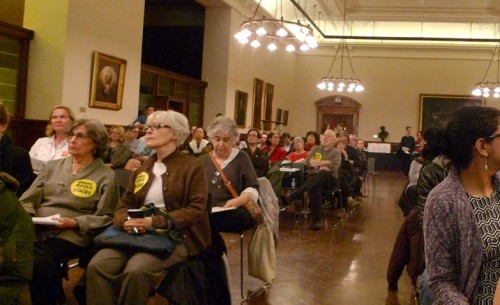Here’s What Happened at NYPL’s Recent Public Forum
Last week, the New York Public Library hosted a public meeting about its proposed “Midtown Campus Renovations.” Library lovers from across the city converged on the Edna Barnes Salomon Room in the 42nd Street Library to voice their concern for the two most popular libraries in the NYPL system.
NYPL President Anthony Marx made brief opening remarks before handing over the presentation to Elliot Felix, the director of Brightspot Strategy. It’s unclear whether Brightspot is involved in the planning of the Midtown library renovations, a project library leaders have frequently described as “staff driven.” Mr. Felix touted NYPL’s work soliciting public feedback through numerous focus groups and an online survey. However, these results are not available to the public.
Very few details of the library’s plans were divulged. Instead, Mr. Felix referred to vague goals of ensuring “access to materials” and providing additional “quiet spaces.” Shortly afterwards, meeting participants divided into break-out groups focused on research, core services, PK-12 education, adult education, or small business. Fortunately, CSNYPL members were present in each group. Most were led by Brightspot consultants rather than NYPL librarians. Participants were instructed to respond to narrowly defined questions, and responses were reduced into short and sometimes misleading summaries written on flip pads.
Anne Thornton, director of research services, greeted the research group, but immediately turned the proceedings over to Elliot Felix. Asked to describe an ideal research experience, scholars insisted it was imperative to have the books on site, to be able to read them in a quiet space, and to have knowledgeable librarians available in the reading room. Others stressed the key element of time in research. When there may be days before an additional book is in the researcher’s hands, the original creative impetus is dimmed, if not lost. For researchers from out of town, time is of the essence and availability must be predictable for them. The last speaker praised the efficiency of the stacks and how they ensured prompt delivery to the reading room. Researchers, she insisted, would be better served with more materials available on-site. The need to return the books to the stacks was mentioned by almost every speaker; many participants also wore highly visible yellow sticks which stated “Bring Books back to the Stacks.”
In the core service group, attendees voiced unanimous support for rehabilitating the 42nd Street book stacks and keeping books in both libraries. A Guttman Community College faculty member stressed the need for her students to quickly access books at the 42nd Street library. There was a broad consensus on the need for preserving “quiet space” in libraries, hiring more librarians with M.L.S degrees, and providing ESL classes in Mid-Manhattan. Several members urged NYPL to adopt a more transparent decision making process, however, the Brightspot facilitator adamantly refused to include this point in her summary.
Those present in the business group began by observing that the questions posed by the facilitator ignored key questions about the fate of the Science Industry and Business Library (SIBL) at 34th Street and the need to maximize the number of books quickly available to mid-town library users. They requested support for more private space, meeting rooms, and business counseling programs. Nearly everyone voiced their opposition to the sale of SIBL. When pressed to explain what would happen to the Science and Industry component of SIBL, it was revealed NYPL will no longer provide a comprehensive science and industry collection. SIBL librarian Kristin McDonough forthrightly explained NYPL’s current plans to divide and scatter SIBL functions and accurately reported participant comments to the whole group. This made a striking contrast to skewed and incomplete flip pad notes made by the Brightspot facilitator.
The carefully controlled and choreographed meeting was evidently designed to give the impression NYPL leaders are engaging with the public. Facilitators never bothered to distinguish between the Mid-Manhattan Library and the 42nd Street Library when summarizing group feedback, even though many respondents specified how these buildings should be used. Dividing the public into separate groups and the use of Brightspot “facilitators” kept participants at arm’s length from library officials and this undermined the goal of open dialogue.
The demand to return books to the stacks—by far the most common request—was entirely ignored.
At the end of the meeting, Ken Weine (NYPL’s Vice President of Communications) promised additional public meetings as plans progress.
NYPL officials must make a real effort to incorporate feedback from library patrons into their plans for the 42nd Street and Mid-Manhattan Libraries. The public has repeatedly and forcefully expressed its preference to keep as much of the NYPL research collection quickly accessible in the 42nd Street Library, to support and rebuild library staff, and to make prudent use of existing facilities. Future NYPL actions will show us if Library leaders are listening.

